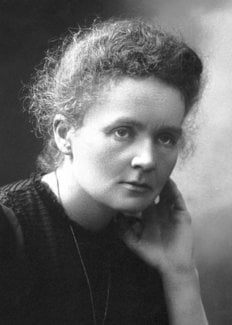Marie Curie
Biographical

Marie Curie, née Maria Sklodowska, was born in Warsaw on November 7, 1867, the daughter of a secondary-school teacher. She received a general education in local schools and some scientific training from her father. She became involved in a students’ revolutionary organization and found it prudent to leave Warsaw, then in the part of Poland dominated by Russia, for Cracow, which at that time was under Austrian rule. In 1891, she went to Paris to continue her studies at the Sorbonne where she obtained Licenciateships in Physics and the Mathematical Sciences. She met Pierre Curie, Professor in the School of Physics, in 1894 and in the following year they were married. She succeeded her husband as Head of the Physics Laboratory at the Sorbonne, gained her Doctor of Science degree in 1903, and following the tragic death of Pierre Curie in 1906, she took his place as Professor of General Physics in the Faculty of Sciences, the first time a woman had held this position. She was also appointed Director of the Curie Laboratory in the Radium Institute of the University of Paris, founded in 1914.
Her early researches, together with her husband, were often performed under difficult conditions, laboratory arrangements were poor and both had to undertake much teaching to earn a livelihood. The discovery of radioactivity by Henri Becquerel in 1896 inspired the Curies in their brilliant researches and analyses which led to the isolation of polonium, named after the country of Marie’s birth, and radium. Mme. Curie developed methods for the separation of radium from radioactive residues in sufficient quantities to allow for its characterization and the careful study of its properties, therapeutic properties in particular.
Mme. Curie throughout her life actively promoted the use of radium to alleviate suffering and during World War I, assisted by her daughter, Iréne, she personally devoted herself to this remedial work. She retained her enthusiasm for science throughout her life and did much to establish a radioactivity laboratory in her native city – in 1929 President Hoover of the United States presented her with a gift of $50,000 donated by American friends of science, to purchase radium for use in the laboratory in Warsaw.
Mme. Curie, quiet, dignified and unassuming, was held in high esteem and admiration by scientists throughout the world. She was a member of the Conseil du Physique Solvay from 1911 until her death and since 1922 she had been a member of the Committee of Intellectual Co-operation of the League of Nations. Her work is recorded in numerous papers in scientific journals and she is the author of Recherches sur les Substances Radioactives (Investigations on radioactive substances) (1904), L’Isotopie et les Eléments Isotopes (Isotopy and isotopic elements) and the classic Traité de radioactivité (Treatise on radioactivity) (1910).
The importance of Mme. Curie’s work is reflected in the numerous awards bestowed on her. She received many honorary science, medicine and law degrees and honorary memberships of learned societies throughout the world. Together with her husband, she was awarded half of the Nobel Prize for Physics in 1903, for their study into the spontaneous radiation discovered by Becquerel, who was awarded the other half of the Prize. In 1911 she received a second Nobel Prize, this time in Chemistry, in recognition of her work in radioactivity. She also received, jointly with her husband, the Davy Medal of the Royal Society in 1903 and, in 1921, President Harding of the United States, on behalf of the women of America, presented her with one gram of radium in recognition of her service to science.
The Curie’s elder daughter, Iréne, married Frédéric Joliot in 1926 and they were joint recipients of the Nobel Prize for Chemistry in 1935. The younger daughter, Eve, married the American diplomat H.R. Labouisse. They have both taken lively interest in social problems, and as Director of the United Nations’ Children’s Fund he received on its behalf the Nobel Peace Prize in Oslo in 1965. She is the author of a famous biography of her mother, Madame Curie (Gallimard, Paris, 1938), translated into several languages.
Mme. Curie died in Savoy, France, after a short illness, on July 4, 1934.
This autobiography/biography was written at the time of the award and first published in the book series Les Prix Nobel. It was later edited and republished in Nobel Lectures. To cite this document, always state the source as shown above.
The Nobel Foundation's copyright has expired.Nobel Prizes and laureates
Six prizes were awarded for achievements that have conferred the greatest benefit to humankind. The 14 laureates' work and discoveries range from quantum tunnelling to promoting democratic rights.
See them all presented here.
